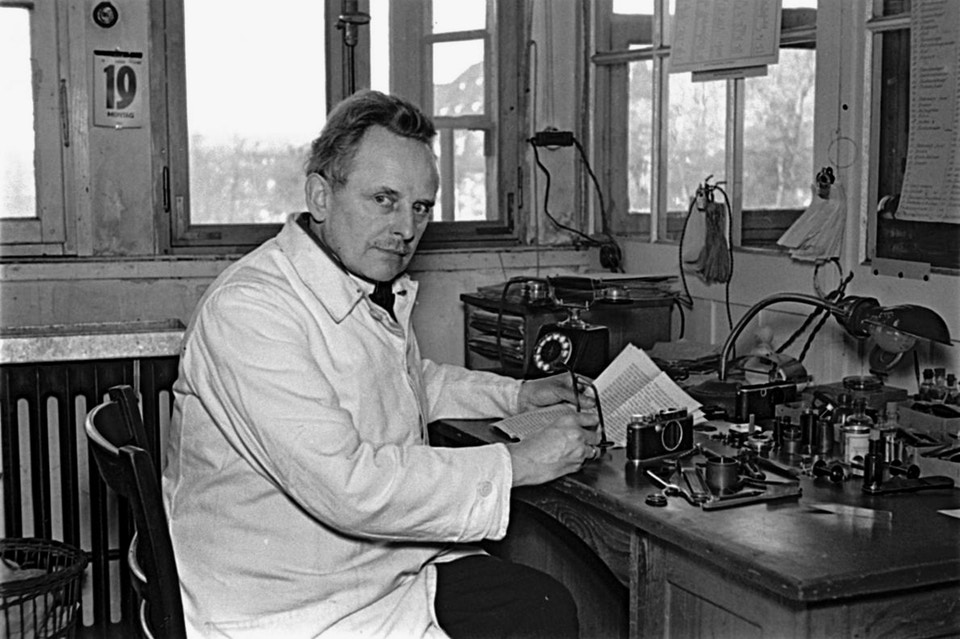Ernst Leitz was the man who decided to take the Leica camera into production. That was a very important and bold decision in economically challenging times.
But he couldn’t have taken this decision if Oskar Barnack hadn’t developed such an innovating camera as he did.
He developed the camera on his own account.
Oskar was born on the first of November 1879 in Linow close to Berlin. At the age of three he and his family moved to Berlin. He came from a humble background. In 1908 he started to work in Jena at the microscope development department of Zeiss. There he met Emil Mecher, who became his friend. Emil took a job at Ernst Leitz in Wetzlar, where he soon recommended Oskar Barnack for a position of master mechanic at the microscope development department. In those days Leitz didn't develop cameras yet.
Oskar Barnack suffered from asthma and warned Ernst Leitz II that he would have to take leave on a regular basis, for recuperating from this disease. As we will find out later in this article, his asthma became the determining factor in the success of the Leica. Ernst Leitz, who had a good eye for talent, still wanted him to join the Leitz factories. So in 1911 Oskar Barnack left from Jena to Wetzlar, more than 250 km apart from each other. Apart from his work for the microscope development he also worked on the development of a cine camera.
Barnack was a good amateur photographer and he regularly went out in the weekends in the hills around Wetzlar, for practising his hobby.
In those days a photographer took a bulky and heavy box camera, big photographic plates and a heavy tripod. With his asthma this wasn’t easy and he started to think about developing a much lighter and smaller camera. His experience with the Cine camera gave him the idea to use cine film for his camera. The quality of this film was quit well and he thought it could be used for photographical use. To further improve sharpness and grain he decided to use it in double the format of the cine cameras did. So instead of using 12 x 18 he used 36 x 24 mm. This also had the advantage that the design of the camera would be landscape instead of portrait, which gave it better ergonomic properties.
By 1914 his Lilliput camera was ready to use. He made his Ur Leica in two different versions and used them a lot. Ernst Leitz II took one of these Ur Leica’s to The US.
Only after WWI ended in 1918 Barnack could work on further improvements of his camera. In Leica Fact 7 you will find more on the development of the Lilliput camera before the production process started in 1924.
It must be assumed that the research by Barnack was years ahead of production. For instance already in 1923 Leitz marketed a rangefinder for third party, large format, cameras. The development and production sequence must have been developed already at least one year before. In his mind Barnack must have been thinking of a coupled rangefinder Leica already at that time (so some 9 years before the introduction of the Leica II in 1932). The lifetime of the Leica 1a was quite long: introduction in 1925 and successor 1c in 1931. So 6 years without a new camera. And then in the thirties 6 new cameras were introduced. And not only cameras, but also a large number of accessories were put on the market, whereas in 1931 only very few accessories could be bought. It must have been the driving force of Barnack who emphasised his development department to complete the Leica system camera. It is known that Barnack himself made many drawings and notes of new products. In nowadays auctions you will find these notes, all signed by Oskar Barnack. The sale of these accessories must have been a major part of the turnover by Leitz.
When Oskar Barnack died from pneumonia in 1936 Leica cameras were accepted, not only by serious amateurs, but also international press photographers. After his dead it took Leitz 16 years to come with a new breakthrough: The Leica M series with bayonet mount.
Until today, not only the Leica brand is still working with his legacy, but all digital mainframe cameras take advantage of his invention.
